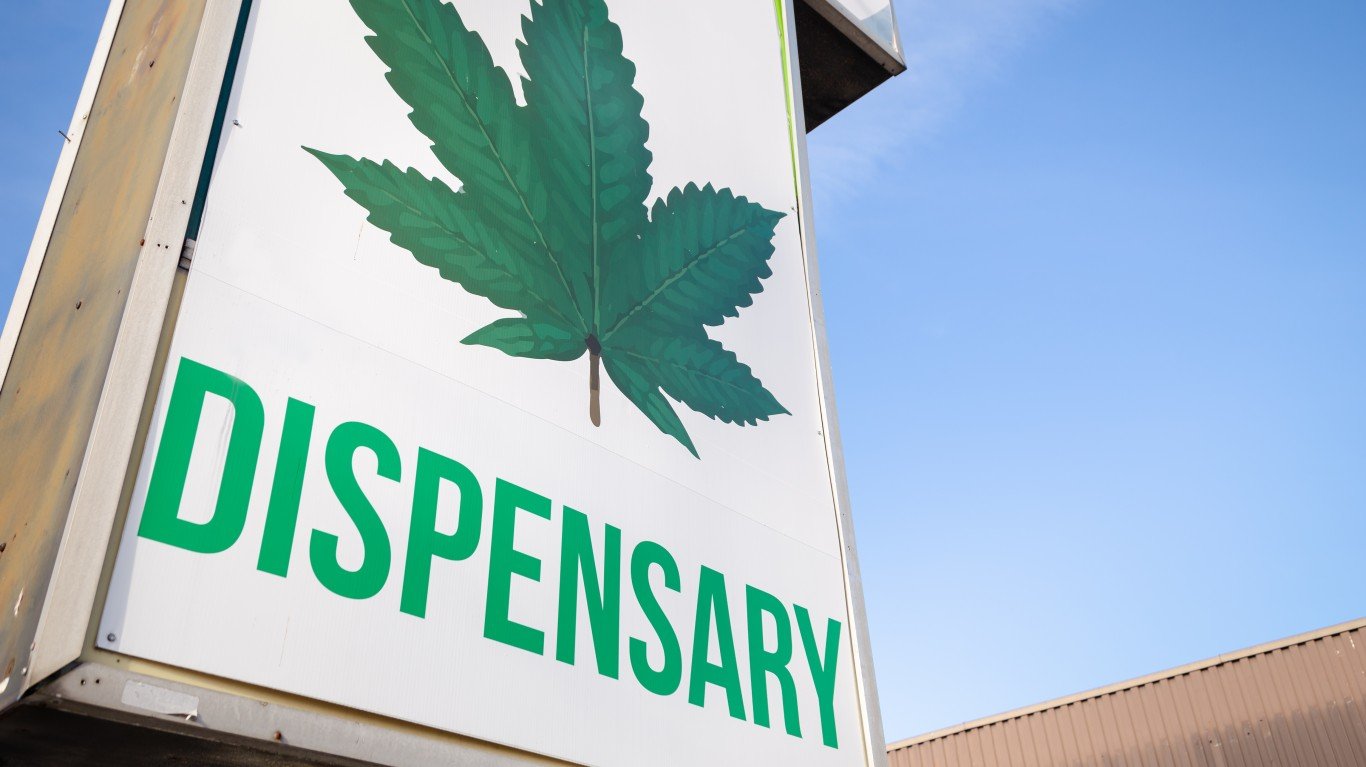

Arrests for marijuana possession topped half a million in 2019, more than the number of arrests for any other drug abuse offense tracked by the FBI. That same year, a survey conducted by Pew Research Center found that 67% of Americans support marijuana legalization, up from just 16% three decades earlier.
Marijuana has been criminalized under federal law since 1937. But in states across the country, changing attitudes towards pot are increasingly reflected in new legislation that stands directly at odds with the federal prohibition.
24/7 Wall St. identified the 15 states where recreational use of marijuana has been legalized. We also reviewed annual state excise tax revenue as well as revenue estimates from marijuana sales from the tax policy research organization, the Tax Foundation. Estimates on annual marijuana usage rates are based on the results of a 2018 and 2019 survey conducted by the Substance Abuse and Mental Health Services Administration.
In each of the states on this list, legalization has occurred within the last decade. The first states to fully end marijuana prohibition did so through 2012 ballot measures, and four states moved to legalize cannabis as recently as 2020. In most states, legalization has been the product of voter-sponsored ballot initiatives that received popular support on election day. Illinois, New Jersey, and Vermont are the only states where elected lawmakers have introduced and passed bills to repeal the drug’s prohibition.
The number of states where recreational marijuana use is legal will not likely remain at 15 for long. As the drug garners increasing mainstream acceptance legalization will likely be adopted by more state governments — even those that do not allow voter ballot initiatives. Here is a look at the next 9 states to legalize marijuana.
Nationwide, 16.7% of the 18 and older population have used marijuana in the past year. Usage rates in the states on this list tend to be higher than average.
Click here to see 15 states where marijuana is legal.

1. Alaska
> Year legal status approved: 2015
> Adults who have used marijuana in the last year: 136,000 (24.6% of 18+ pop)
Alaska became one of the first states to legalize recreational marijuana use when voters approved a ballot measure in November 2014 by a 53% to 47% margin. Since regulated retail sales of the drug began in October 2016, Alaska’s balance sheets have benefited more and more each year. Revenue from excise taxes on cannabis sales climbed from $1.7 million in fiscal 2017 to $11.1 million in 2018 to $19.2 million in 2019.
Though marijuana is fully legalized in Alaska, state residents who were arrested for marijuana offenses during the drug’s prohibition still have those charges on their criminal history. Advocates are currently pushing for expungement of criminal records for previous marijuana crimes that involved less than 1 ounce of the drug.
[in-text-ad]

2. Arizona
> Year legal status approved: 2020
> Adults who have used marijuana in the last year: 896,000 (15.9% of 18+ pop)
Arizona voters supported Proposition 207 — which legalized recreational marijuana use — with 60% of voters supporting the proposition on Election Day 2020. The new law’s provisions permit state residents 21 and older to possess as much as 1 ounce of pot and cultivate up to six plants in their home. By mid-2021, residents who have criminal records related to marijuana possession will have those offences expunged. Medical marijuana use was legalized in Arizona in 2010.
Arizona will levy a 15% tax on retail marijuana sales. By the time the market for legalized pot has matured, the state expects to bring in an estimated $166.3 million in additional tax revenue.
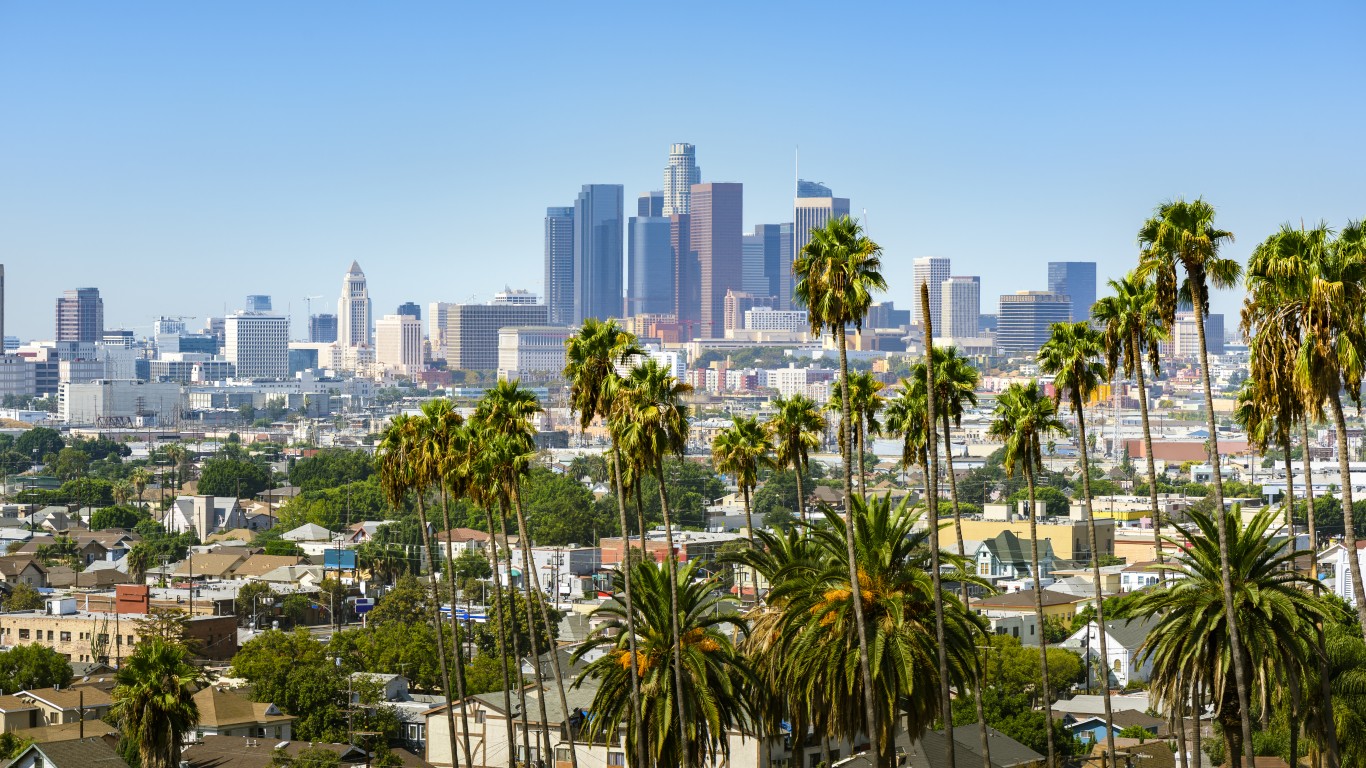
3. California
> Year legal status approved: 2016
> Adults who have used marijuana in the last year: 6,163,000 (20.1% of 18+ pop)
California voters fully legalized marijuana use with Proposition 64 in November 2016. Today, the state is the largest market for recreational pot in the world. Legal marijuana sales totalled $3.1 billion 2019. Yet, due to high excise taxes on marijuana sales, in addition to a well-developed black market, illicit sales of the drug — estimated at around $8.7 billion in 2019 — still account for the bulk of the market share.
Still, since dispensaries opened in California in January 2018, the state has collected nearly $2 billion in revenue from marijuana sales. Tax proceeds from pot sales go towards regulatory costs, research, youth anti-drug programs, environmental programs, and public safety grants.
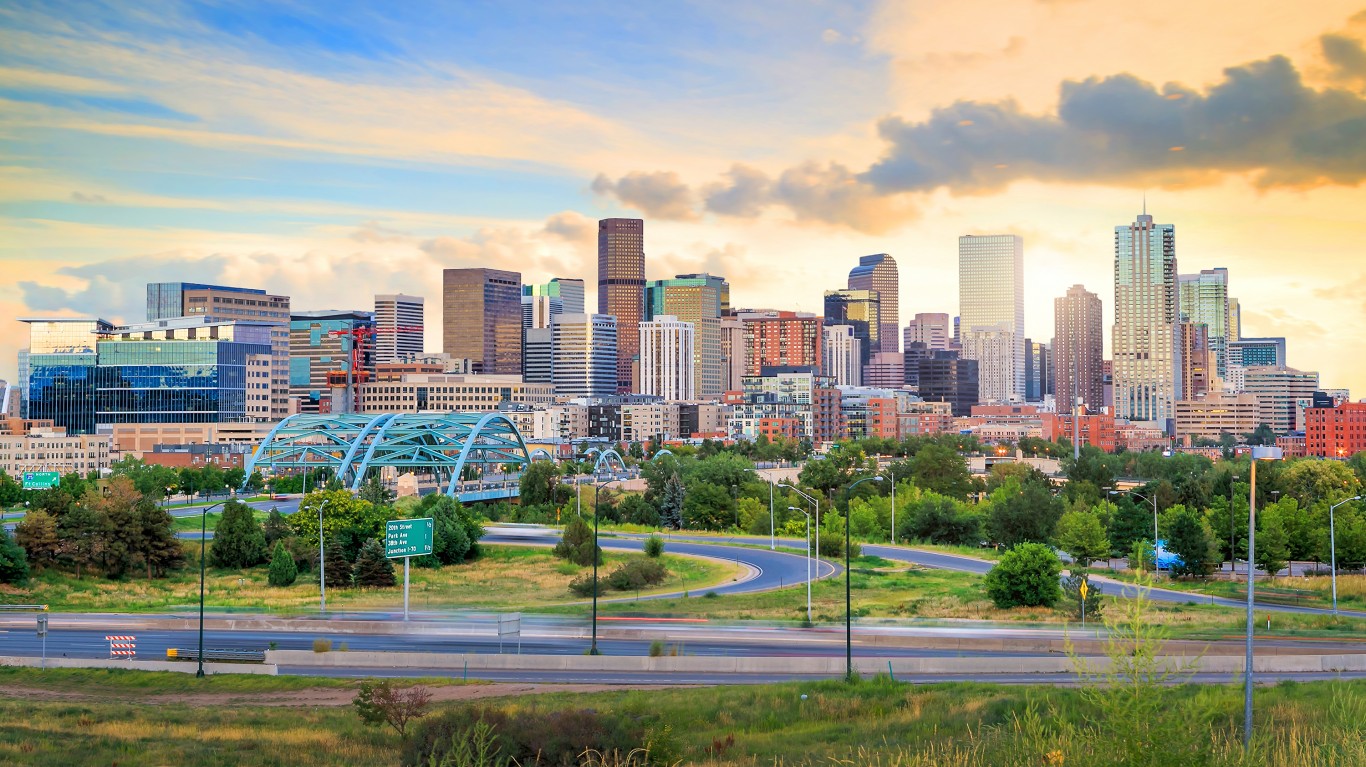
4. Colorado
> Year legal status approved: 2012
> Adults who have used marijuana in the last year: 1,189,000 (26.4% of 18+ pop)
Colorado was a pioneer in pot legalization in the United States. It became the first state to legalize recreational marijuana use when voters passed Proposition 64 in November 2012 by a 55% to 45% margin. The first year of retail sales of the drug in the state brought in $21.6 million in tax revenue. As of fiscal 2019, excise taxes on pot sales topped a quarter of a billion dollars.
Allowing recreational marijuana use for nearly a decade, Colorado has more progressive cannabis policy than many other states on this list. Home delivery of recreational pot was legalized earlier this year, and a new law will also allow businesses like restaurants and hotels to have specific locations set aside for marijuana use.
[in-text-ad-2]
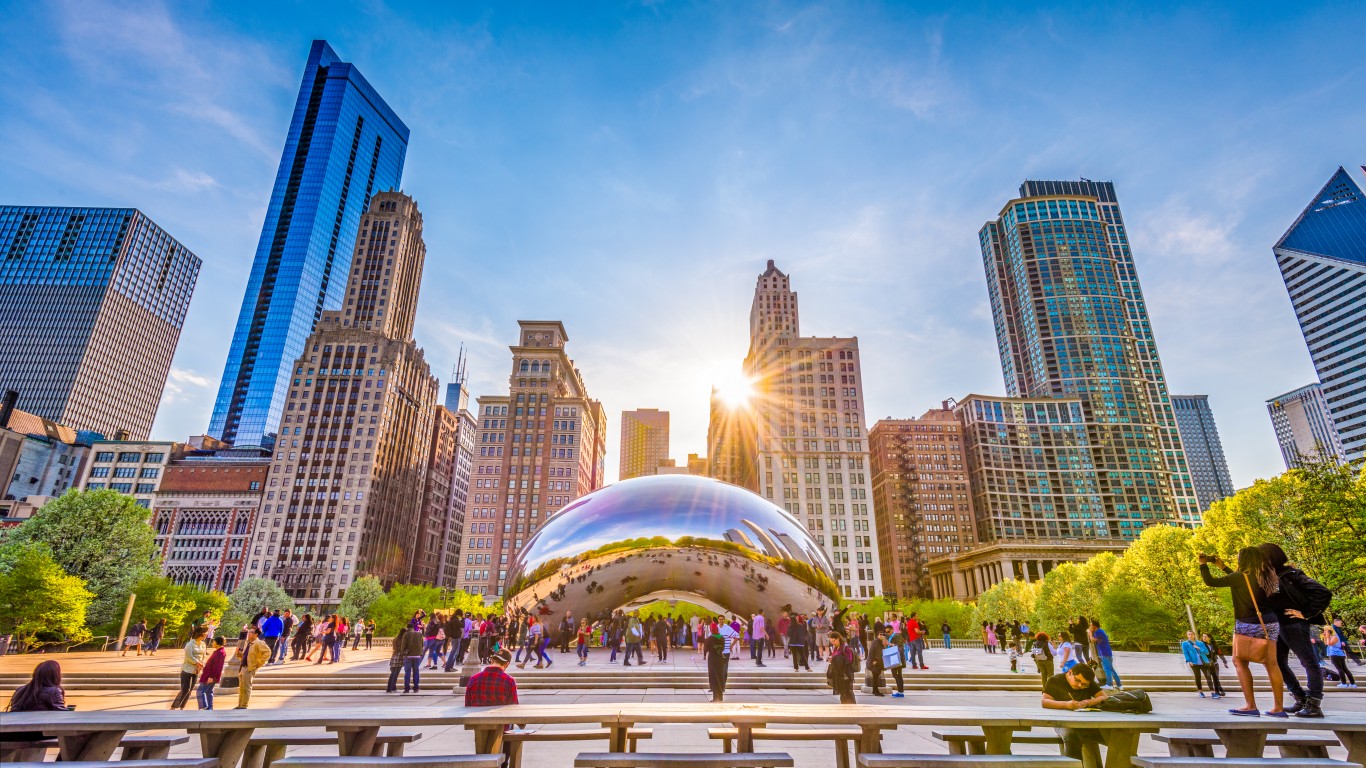
5. Illinois
> Year legal status approved: 2019
> Adults who have used marijuana in the last year: 1,615,000 (16.4% of 18+ pop)
Until the state legislature passed the Illinois Cannabis Regulation and Tax Act in May 2019, every state that had decriminalized recreational pot had done so through a ballot initiative. Following the historic move, recreational marijuana sales began in Illinois on Jan. 1, 2020. Also unlike every other state up to that point, Illinois marijuana tax structure takes potency into account. On top of a 7% wholesale marijuana tax, the state levies a 10% tax on lower potency weed, a 25% tax on higher potency pot, and a 20% tax on marijuana-infused products.
The state estimates it will bring in $127 million in revenue from pot sales in fiscal 2021. Over half of all marijuana tax revenue will go into the state’s general fund and to mental health and substance abuse programs.

6. Maine
> Year legal status approved: 2016
> Adults who have used marijuana in the last year: 273,000 (24.9% of 18+ pop)
Voters in Maine legalized recreational pot use in November 2016. However, due to a series of political hurdles, retail sales of the drug did not begin until October 2020. Retail marijuana sales in the state are subject to a 10% tax, and residents are only permitted to consume marijuana in their homes. Maine law also allows for the cultivation of up to three plants in a private residence.
According to an estimate based on pot sales in other states, Maine could reasonably expect to bring in $59 million in tax revenue per year from pot sales. Most proceeds will go to the state’s general fund, but some will be allocated to marijuana education programs and marijuana focused law enforcement operations.
[in-text-ad]

7. Massachusetts
> Year legal status approved: 2016
> Adults who have used marijuana in the last year: 1,241,000 (22.4% of 18+ pop)
On Election Day 2016, Massachusetts joined its New England neighbor, Maine, in decriminalizing recreational pot use. While retail operations began opening in November 2018, about a third of all cities and towns in the state have a standing ban on pot dispensaries. In addition to the state’s 6.25% general sales tax, retail marijuana sales are subject to a 10.75% excise tax. The state budgeted for revenue from marijuana sales of $132.5 million in fiscal 2020.
As of late 2020, there were over 80 marijuana retailers in Massachusetts that have reported more than $1 billion in sales to date.
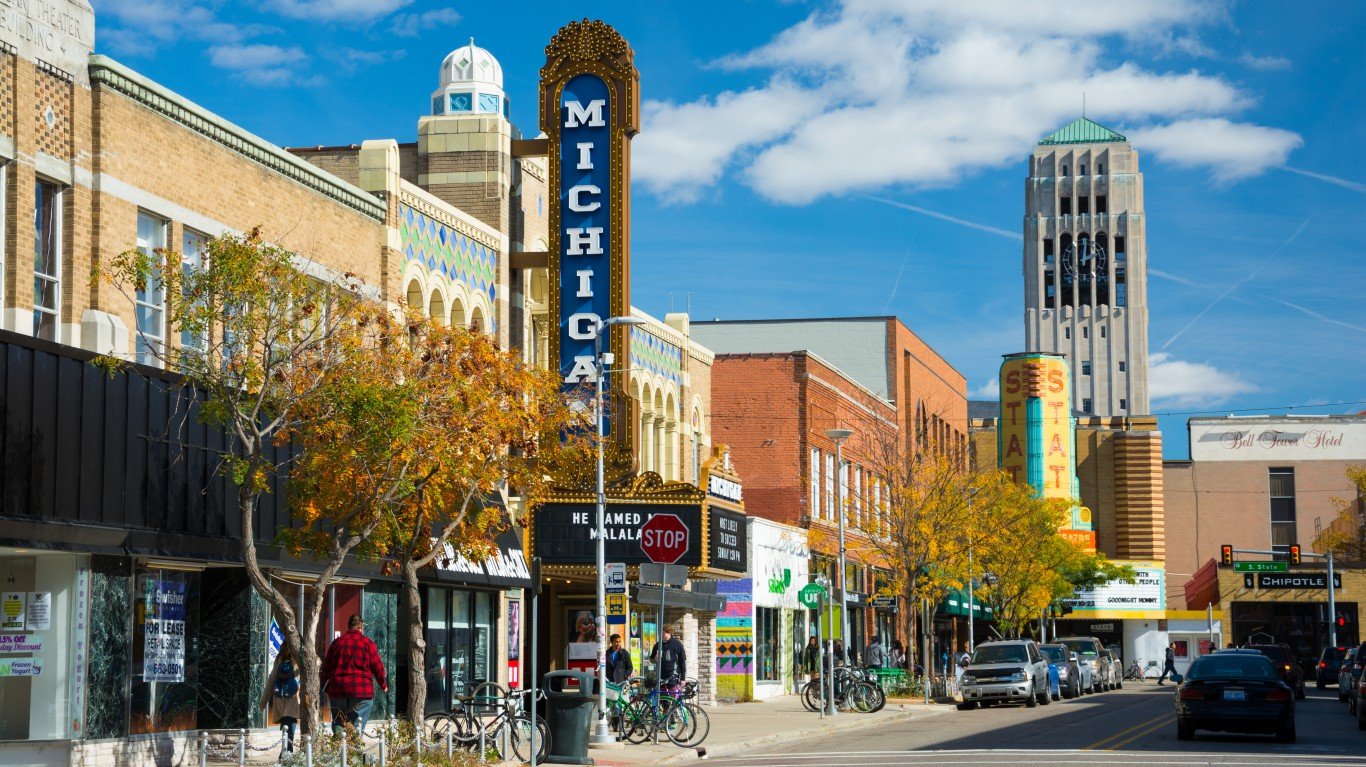
8. Michigan
> Year legal status approved: 2018
> Adults who have used marijuana in the last year: 1,664,000 (21.2% of 18+ pop)
Through a ballot proposal, voters in Michigan legalized recreational marijuana use in November 2018 by a 56% to 44% margin. Regulated sales, which are taxed at a rate of 10% on top of a general 6% sales tax, began at the end of 2019. By the time the legal marijuana market is fully operational in the state in the coming years, the state estimates pot sales could generate as much as $150 million annually in taxes — though these expectations may be overly optimistic due to high uncertainty.
Proceeds from pot sales will go to medical marijuana research, local governments, the state’s School Aid Fund, as well as the Michigan Transportation Fund.
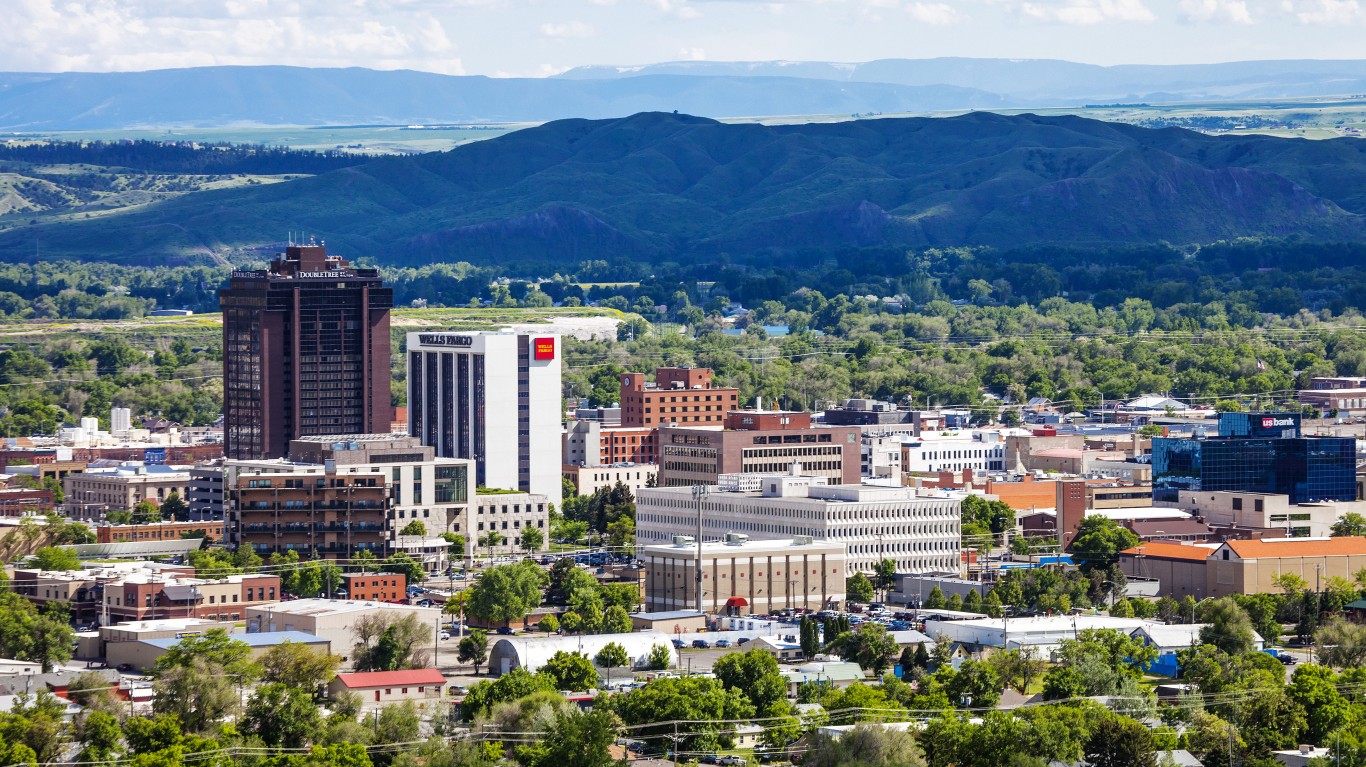
9. Montana
> Year legal status approved: 2020
> Adults who have used marijuana in the last year: 168,000 (19.9% of 18+ pop)
Though two ballot initiatives, Montana voters decriminalized recreational marijuana use for adults 21 and older on Election Day 2020. The state estimates that its 20% excise tax on pot sales will bring in $38.5 million annually by fiscal 2025. These proceeds will be put toward a range of programs, including environmental and wildlife conservation, veteran services, and substance abuse treatment.
Based on 2018 and 2019 survey data, an estimated 19.9% of Montana’s 18 and older population use marijuana at least once a year, compared to 16.7% of all Americans in the same age group.
[in-text-ad-2]
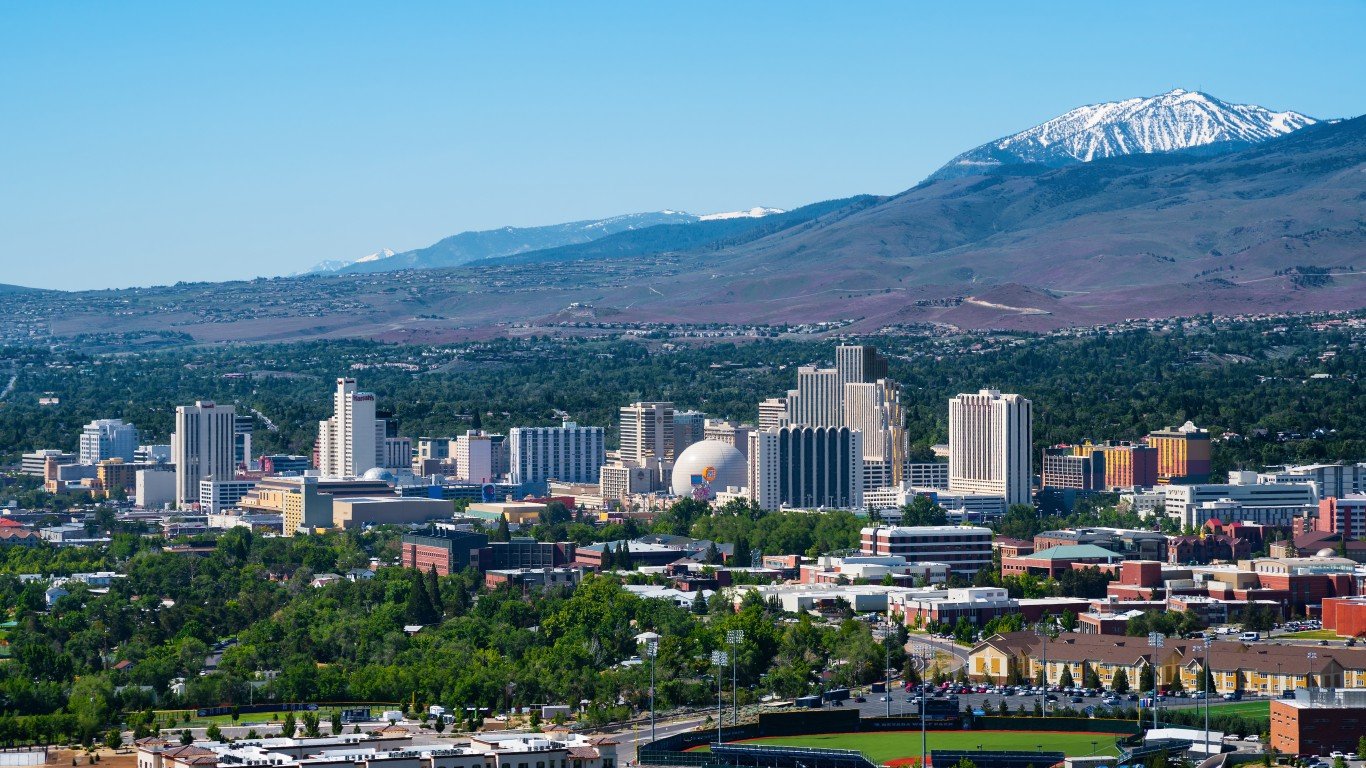
10. Nevada
> Year legal status approved: 2016
> Adults who have used marijuana in the last year: 574,000 (24.0% of 18+ pop)
Through a ballot initiative, voters in Nevada legalized recreational marijuana use in November 2016, with regulated sales of the drug beginning about eight months later. Adults 21 and older in the state can legally purchase pot, paying a 10% sales tax on top of a 15% wholesale tax, for at-home consumption.
In each of the first two full years of legalization, proceeds from excise taxes exceeded expectations, hitting $99 million in fiscal 2019. Marijuana revenue is used to cover the program’s expenses, with the remainder going to schools and the state’s rainy day fund.
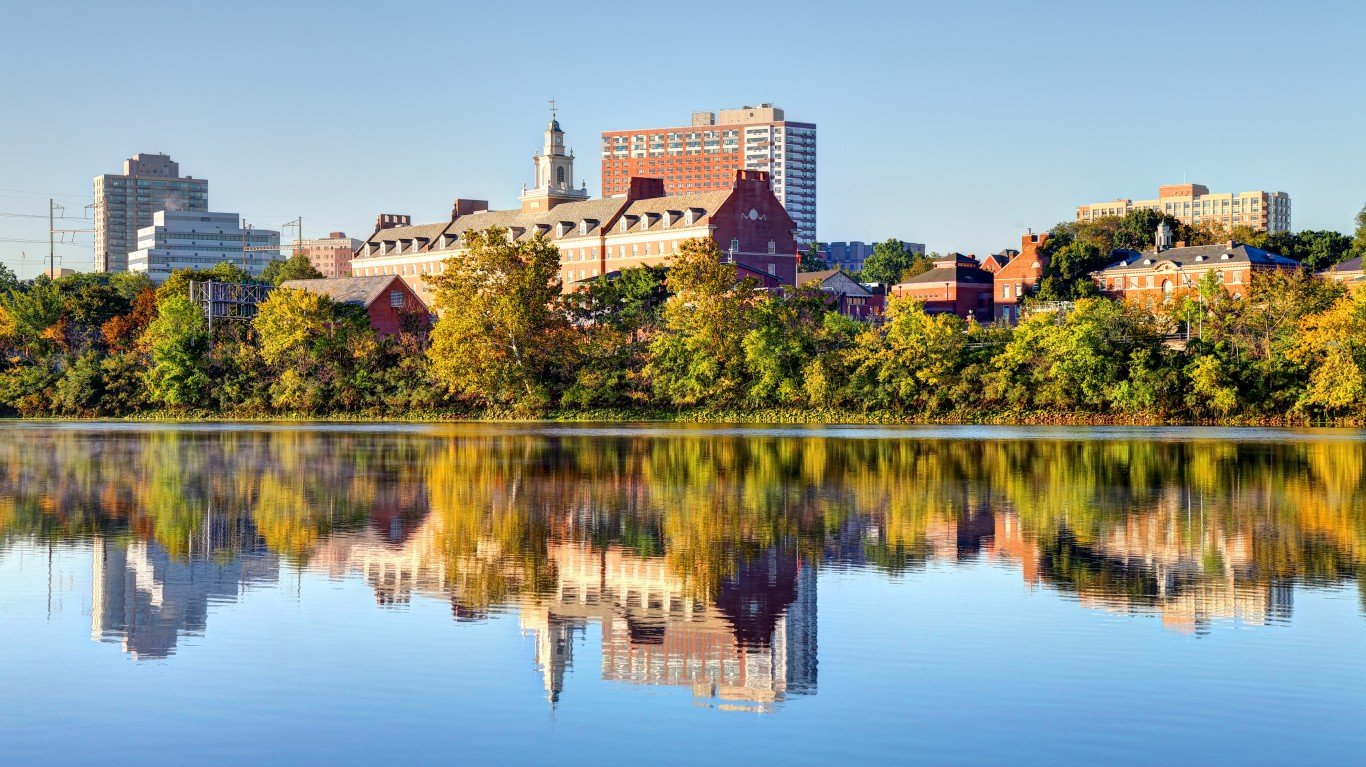
11. New Jersey
> Year legal status approved: 2020
> Adults who have used marijuana in the last year: 955,000 (13.8% of 18+ pop)
In December 2020, New Jersey lawmakers passed bills that allow for the legalization of a regulated marijuana market. It is important to note, however, that possession of the drug will remain illegal in the state as Gov. Phil Murphy is withholding his approval until some additional details related to minors in possession of the drug are worked out.
Once the state’s market is developed, tax revenue from pot sales will go primarily to social justice causes.
[in-text-ad]
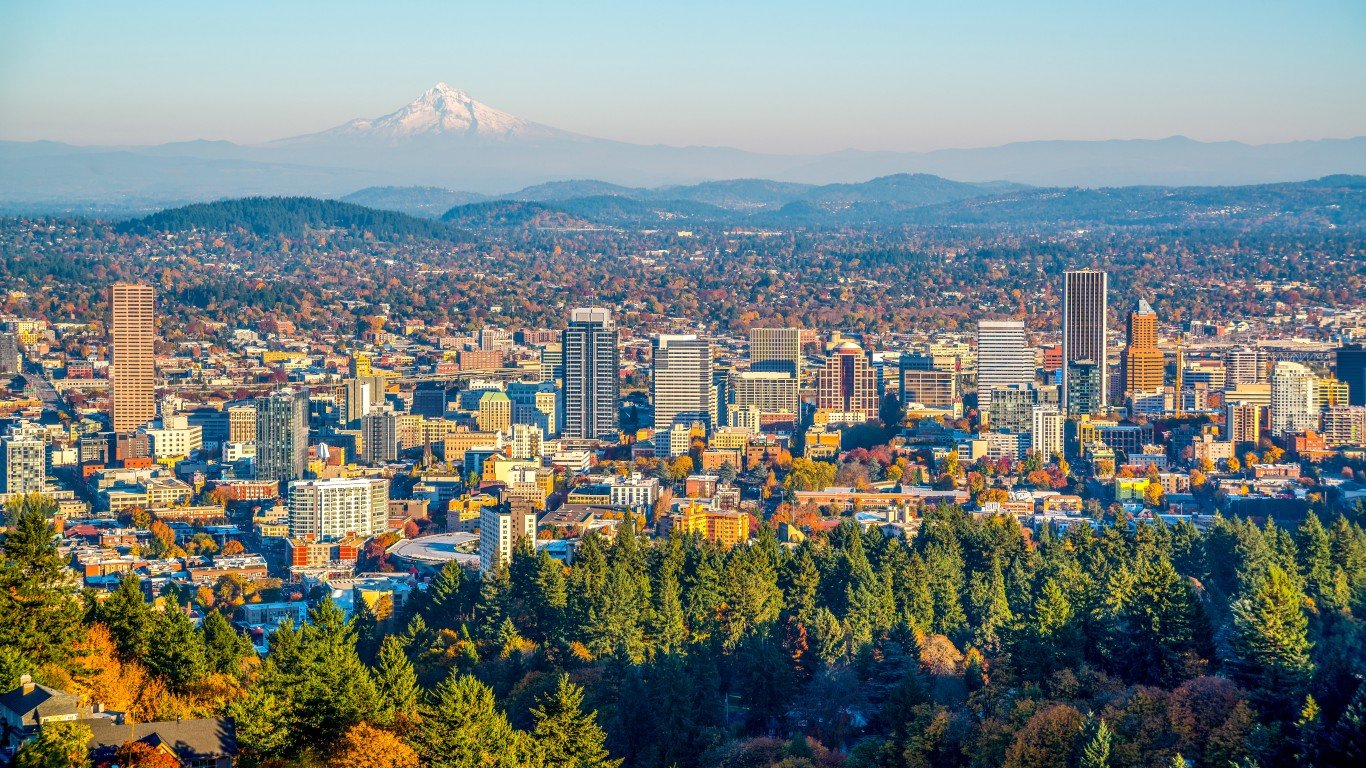
12. Oregon
> Year legal status approved: 2014
> Adults who have used marijuana in the last year: 914,000 (27.2% of 18+ pop)
Voters in Oregon approved decriminalization by a 56% to 44% margin in November 2014. In July 2015, pot possession became legal, and in October of that year, regulated sales of the drug began. Retail pot sales are subject to a 17% tax, and local municipalities can implement their own 3% tax on top of the state tax. Revenue from marijuana sales have climbed each year since legalization, reaching $102 million fiscal 2019, the bulk of which went to schools and mental health and drug services.
In early 2021, Oregon became the first state in the country to decriminalize possession of small amounts of drugs like heroin, LSD, or methamphetamine. Rather than facing arrest, those found in possession will face a $100 fine or possible addiction counseling.

13. South Dakota
> Year legal status approved: 2020
> Adults who have used marijuana in the last year: 73,000 (10.9% of 18+ pop)
Through two ballot measures, voters in South Dakota supported the legalization and regulation of recreational marijuana in November 2020. The move came after decades of some of the most draconian marijuana laws in the country.
While legalization measures are scheduled to take effect on July 1, 2021, opponents of the move have taken action, filing lawsuits in the state’s circuit court to overturn the outcome of the November ballot measures on the grounds that they are unconstitutional. Critics of marijuana legalization include South Dakota Gov. Krisi Noem. If the will of state voters is ultimately upheld, the state estimates marijuana sales will generate $29.3 million in annual tax revenue.
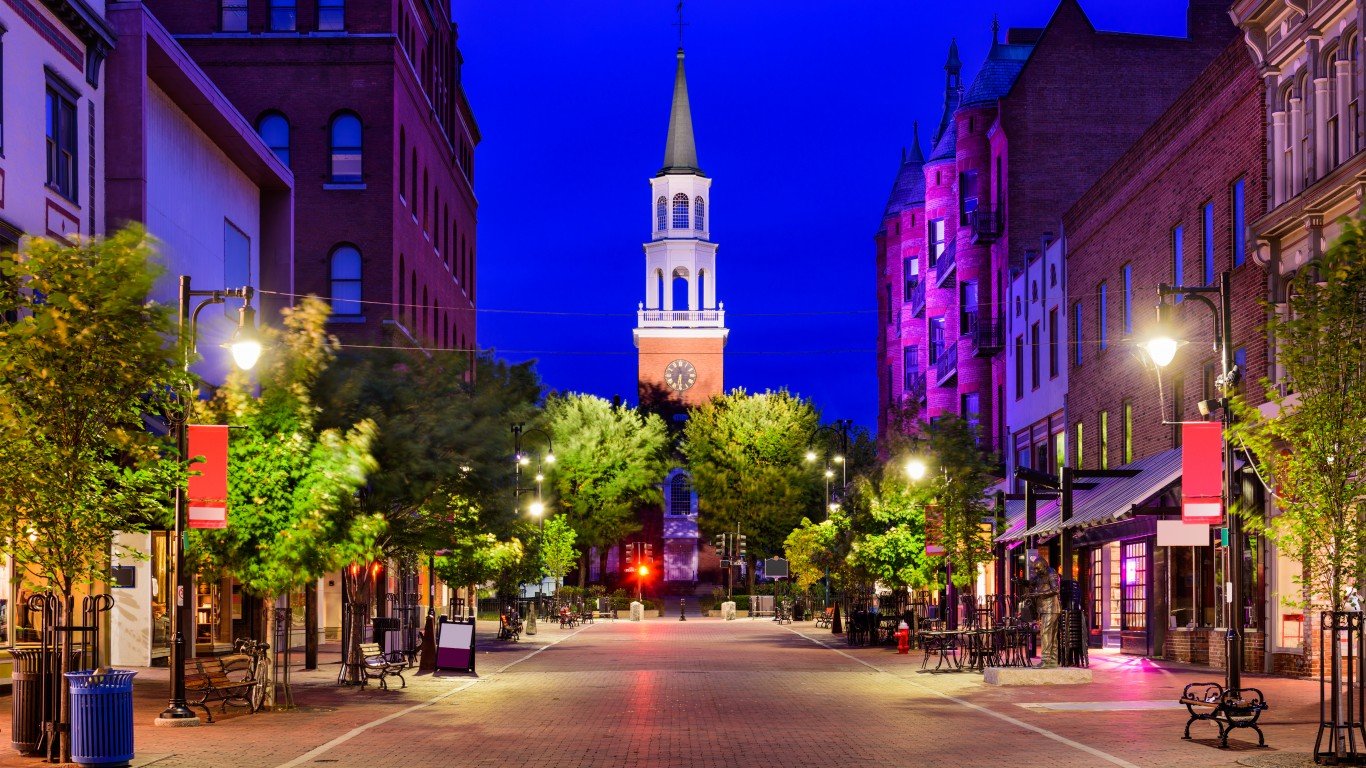
14. Vermont
> Year legal status approved: 2018
> Adults who have used marijuana in the last year: 139,000 (27.2% of 18+ pop)
Vermont state law does not allow for ballot initiatives, and as a result, unlike most states on this list, marijuana legalization in the Green Mountain State came through legislative action. In January 2018, the Vermont House and Senate legalized recreational pot. In October 2020, the state expanded legalization, passing a bill that allows for regulated marijuana sales. Exactly how much revenue Vermont will see from excise taxes remains to be seen. Projections in the bill range from $8.6 to $16.6 million annually.
Marijuana use is relatively common in Vermont. An estimated 27.2% of the 18 and older population have used the drug in the last year, a larger share than in nearly every other state and well above the comparable 16.7% national usage rate.
[in-text-ad-2]

15. Washington
> Year legal status approved: 2012
> Adults who have used marijuana in the last year: 1,535,000 (25.8% of 18+ pop)
Following a 56% to 44% win at the ballot box in November 2012, the legal sale of recreational marijuana began in Washington state on July 8, 2014. Retail pot sales are subject to a 37% tax in the state, and the proceeds from that tax have climbed every year. In fiscal 2015, revenue from pot topped $64.8 million. In fiscal 2019, marijuana taxes brought in $390.4 million. This money goes to the state general fund, local governments, and substance abuse prevention initiatives.
As is often the case in states that have legalized marijuana, Washington has relatively high usage rates. More than one in every four state residents 18 and older have used marijuana at least once in the last year, compared to 16.7% of adults nationwide.
Sponsored: Attention Savvy Investors: Speak to 3 Financial Experts – FREE
Ever wanted an extra set of eyes on an investment you’re considering? Now you can speak with up to 3 financial experts in your area for FREE. By simply
clicking here you can begin to match with financial professionals who can help guide you through the financial decisions you’re making. And the best part? The first conversation with them is free.
Click here to match with up to 3 financial pros who would be excited to help you make financial decisions.
Thank you for reading! Have some feedback for us?
Contact the 24/7 Wall St. editorial team.
 24/7 Wall St.
24/7 Wall St. 24/7 Wall St.
24/7 Wall St.


